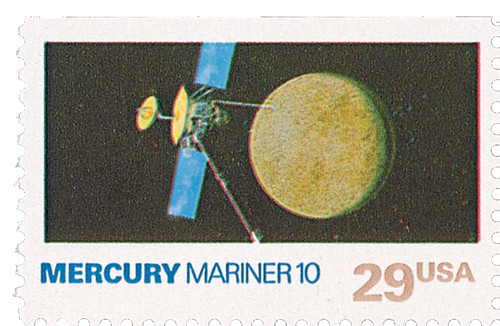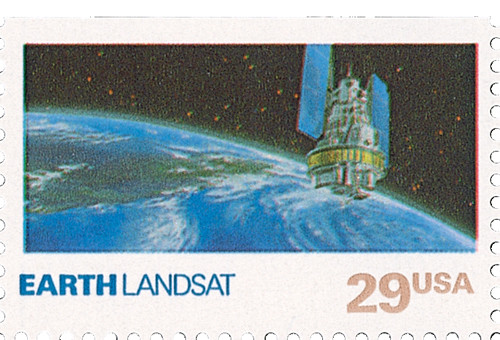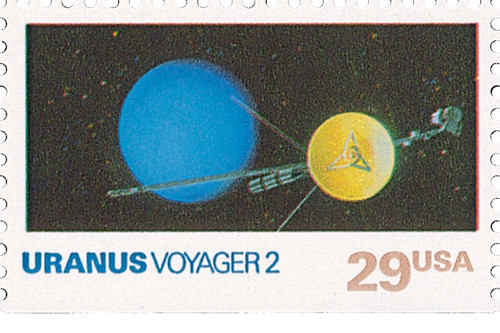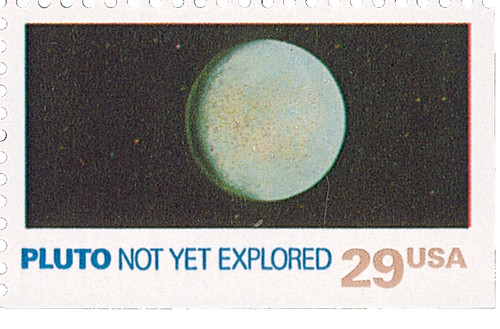
# 2573 - 1991 29c Space Exploration: Jupiter
US #2573
1991 Jupiter
- Part of set picturing nine planets and Earth’s moon
- Issued as part of Stamp Collecting Month
Category of Stamp: Commemorative
Set: Space Exploration
Value: 29¢
First Day of Issue: October 1, 1991
First Day City: Pasadena, California
Quantity Issued: 33,394,800
Printed by: Bureau of Engraving and Printing
Printing Method: Photogravure
Format: Booklets – 2 panes of 10 in each
Perforations: 11
Reason the stamp was issued: The set of Space Exploration stamps was issued in honor of the Voyager 2 space probe passing Neptune and the 11th annual Stamp Collecting Month.
About the stamp design: The Jupiter stamp pictures the planet with the Pioneer 11 flying past. The space probe was launched in April 1973 and flew past Jupiter in November and December 1974. It sent back pictures of the Great Red Spot, the planet’s polar regions, and determined the mass of Jupiter’s moon Callisto.
These stamps were the first by Ron Miller, a former artist for the Smithsonian Institution’s National Air and Space Museum. He was asked to picture each of the Sun’s nine planets and the Earth’s moon with a spacecraft. This was to tie in the idea of America’s exploration of space. His original acrylic paintings were larger than those normally used for stamp art. This was to show all the details of the spacecraft.
Special design details: While most of the stamps name the spacecraft shown, the Pluto stamp has “not yet explored,” because no spacecraft had reached that planet at the time. (The space probe New Horizons explored Pluto in 2015.)
First Day City: The First Day of Issue ceremony took place at the Jet Propulsion Laboratory in Pasadena, California, on October 1, 1991, the start of Stamp Collecting Month.
Unusual thing about this stamp: The USPS partnered with Paramount Studios to promote the stamps. The studio was celebrating the 25th anniversary of the Star Trek movies and television series. The stamp designs were unveiled on the bridge of the Starship Enterprise, the space vehicle featured in the series. Flyers promoting the stamps were included in the packaging of Star Trek video cassettes.
About National Stamp Collecting Month stamps: October has been designated by the US Postal Service as National Stamp Collecting Month. The first celebration occurred in 1981 as a way to promote the hobby of collecting stamps. Each year, new stamps are issued in early October to stimulate additional interest, and many philatelic organizations hold special programs during the month. The theme for the 1991 celebration was “Journey to a New Frontier… Collect Stamps.”
History the Space Exploration stamps represent: Uncovering the mysteries of the universe has been a pursuit of scientists and dreamers for all time. With the invention of telescopes, astronomers discovered some of the wonders of space. With the space age, researchers began sending spacecraft outside of Earth’s orbit to gain further insight into the planets of our solar system. Manned missions were followed by unmanned missions with the capability of traveling to distant planets. These stamps show some of the spacecraft and the images of the planets they captured as they flew by. Discoveries continue to be made with the space probes that still travel through our solar system.
History of Jupiter stamp:
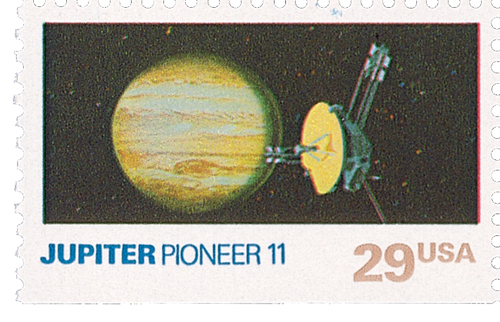
On April 5, 1973 (some sources cite April 6 UTC (Coordinated Universal Time)), the Pioneer 11 space probe launched from Cape Canaveral, Florida.
The Pioneer program was a series of unmanned missions that explored the planets before leaving the solar system. Pioneer 10 and 11 were both approved in February 1969 and were the first probes to be designed to explore the outer solar system.

The mission of Pioneer 11 was to collect data about the atmosphere of Jupiter and Saturn, as well as to further man's understanding of solar winds and cosmic rays. The spacecraft was just over a foot in diameter weighed 571 pounds, and had six 30-inch panels projecting from it. It was powered by a radioisotope thermoelectric generator, which converted heat from the decay of radioactive material into electricity. Its instruments included analyzers for detecting solar wind particles and telescopes for collecting data about cosmic ray and atomic particles.

Sensors detected meteoroids and hydrogen and helium levels. Another telescope relayed images of Jupiter and Saturn back to earth. The computer on board was primitive by modern standards. It could store about 6,000 bytes of information. Many of today's smartphones hold billions of bytes of data. Like Pioneer 10 before it, Pioneer 11 carried a golden plaque picturing a man and a woman along with other information about our origins and the probe, in case it was ever found by extraterrestrials.
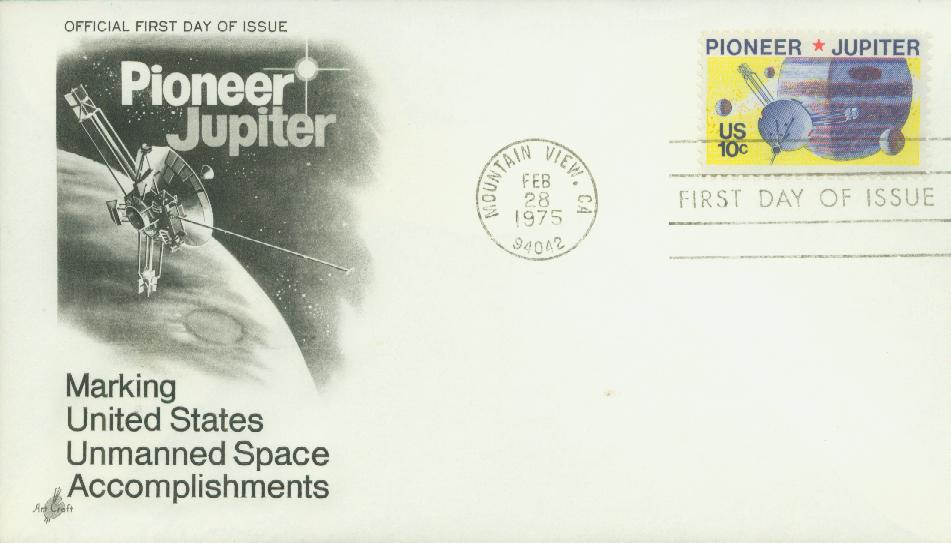
Pioneer 11 was launched toward Jupiter on April 6, 1973, about 13 months after Pioneer 10 had launched. Initially, Pioneer 11 was built as a backup to Pioneer 10. Once Pioneer 10 successfully completed its primary mission of observing Jupiter, NASA came up with a new plan for Pioneer 11. They would adjust the probe's trajectory so that it could use Jupiter's gravity to slingshot around the planet and head toward Saturn.
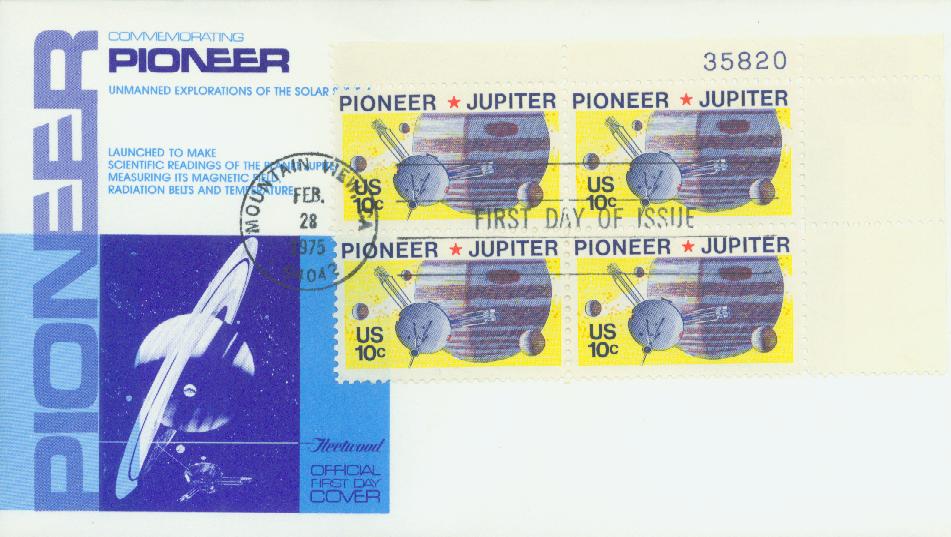
The adjustment worked and in November 1974, Pioneer 11 encountered Jupiter and began sending back data about the planet. It was closest to Jupiter on December 2, when it passed over 26,000 miles above the clouds. A year earlier, Pioneer 10 had passed within 81,000 miles. The space probe recorded the first detailed images of the Great Red Spot and the planet's polar regions. After two months, Pioneer 11 was on its way toward Saturn.
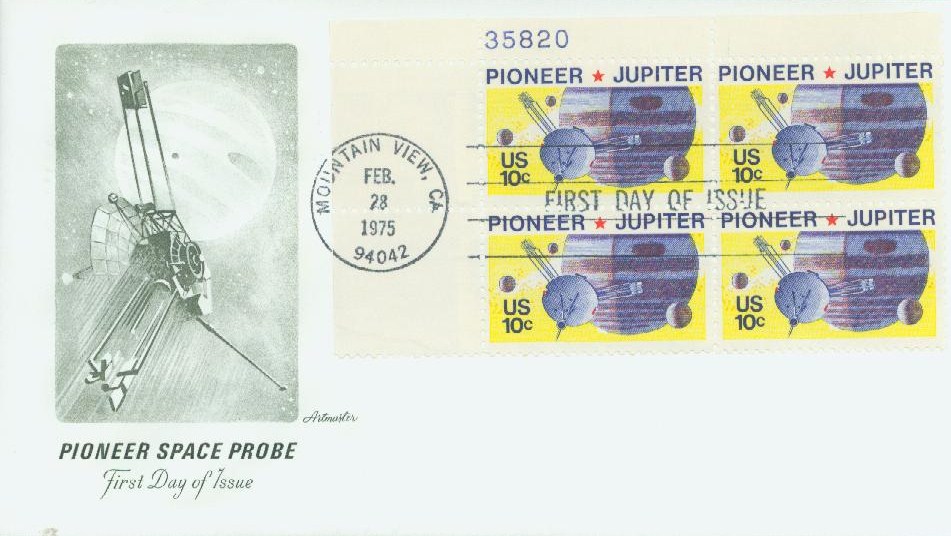
The probe became the first to encounter Saturn in September 1979. The controllers on earth decided to send the probe through the planet's ring to test the route for the Voyager spacecraft, which were also approaching Saturn. Pioneer 11Âmade it through without damage, paving the way for future missions.
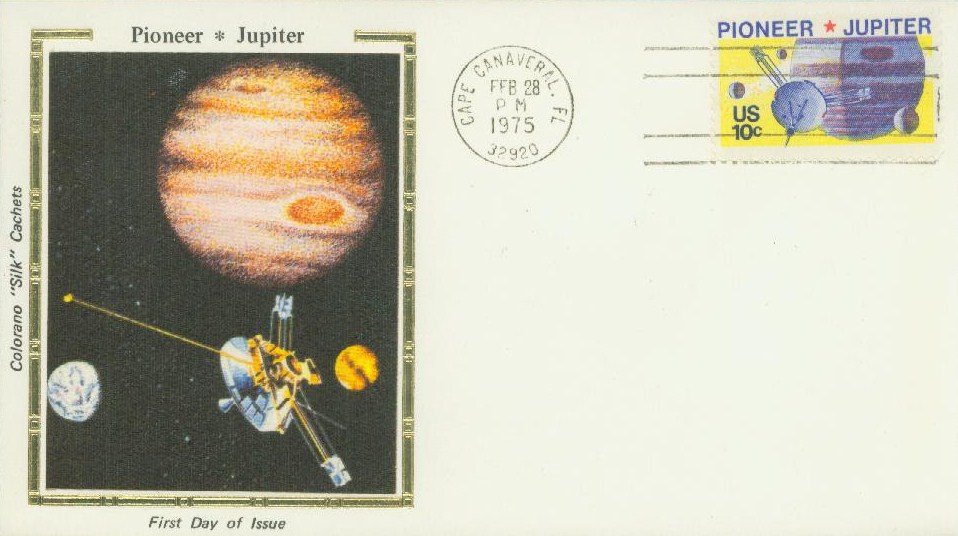
While studying Saturn, the space probe discovered an unknown moon and an additional ring. It barely missed colliding with another moon when it flew within 2,500 miles of it - a near miss in space terms.

On September 29, 1995, the research center connected with the mission released a statement that said in part, "After nearly 22 years of exploration out to the farthest reaches of the Solar System, one of the most durable and productive space missions in history will come to a close."
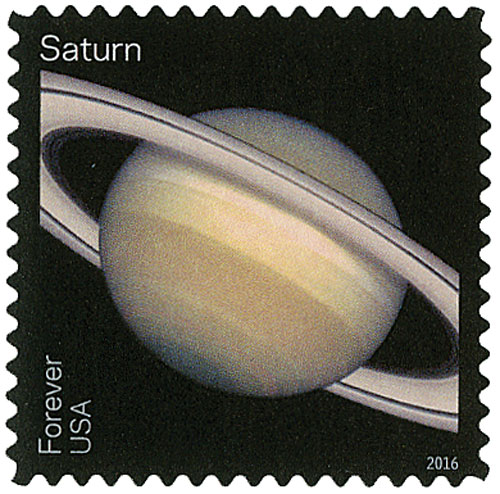
Pioneer 11 continued to travel into space. In July 2015, it was estimated to be over eight billion miles from earth. In the words of a NASA administrator, the space probe was "a venerable explorer that has taught us a great deal about the Solar System and about our own innate drive to learn."
Click here for more info and images from the Pioneer 11 mission from NASA.
US #2573
1991 Jupiter
- Part of set picturing nine planets and Earth’s moon
- Issued as part of Stamp Collecting Month
Category of Stamp: Commemorative
Set: Space Exploration
Value: 29¢
First Day of Issue: October 1, 1991
First Day City: Pasadena, California
Quantity Issued: 33,394,800
Printed by: Bureau of Engraving and Printing
Printing Method: Photogravure
Format: Booklets – 2 panes of 10 in each
Perforations: 11
Reason the stamp was issued: The set of Space Exploration stamps was issued in honor of the Voyager 2 space probe passing Neptune and the 11th annual Stamp Collecting Month.
About the stamp design: The Jupiter stamp pictures the planet with the Pioneer 11 flying past. The space probe was launched in April 1973 and flew past Jupiter in November and December 1974. It sent back pictures of the Great Red Spot, the planet’s polar regions, and determined the mass of Jupiter’s moon Callisto.
These stamps were the first by Ron Miller, a former artist for the Smithsonian Institution’s National Air and Space Museum. He was asked to picture each of the Sun’s nine planets and the Earth’s moon with a spacecraft. This was to tie in the idea of America’s exploration of space. His original acrylic paintings were larger than those normally used for stamp art. This was to show all the details of the spacecraft.
Special design details: While most of the stamps name the spacecraft shown, the Pluto stamp has “not yet explored,” because no spacecraft had reached that planet at the time. (The space probe New Horizons explored Pluto in 2015.)
First Day City: The First Day of Issue ceremony took place at the Jet Propulsion Laboratory in Pasadena, California, on October 1, 1991, the start of Stamp Collecting Month.
Unusual thing about this stamp: The USPS partnered with Paramount Studios to promote the stamps. The studio was celebrating the 25th anniversary of the Star Trek movies and television series. The stamp designs were unveiled on the bridge of the Starship Enterprise, the space vehicle featured in the series. Flyers promoting the stamps were included in the packaging of Star Trek video cassettes.
About National Stamp Collecting Month stamps: October has been designated by the US Postal Service as National Stamp Collecting Month. The first celebration occurred in 1981 as a way to promote the hobby of collecting stamps. Each year, new stamps are issued in early October to stimulate additional interest, and many philatelic organizations hold special programs during the month. The theme for the 1991 celebration was “Journey to a New Frontier… Collect Stamps.”
History the Space Exploration stamps represent: Uncovering the mysteries of the universe has been a pursuit of scientists and dreamers for all time. With the invention of telescopes, astronomers discovered some of the wonders of space. With the space age, researchers began sending spacecraft outside of Earth’s orbit to gain further insight into the planets of our solar system. Manned missions were followed by unmanned missions with the capability of traveling to distant planets. These stamps show some of the spacecraft and the images of the planets they captured as they flew by. Discoveries continue to be made with the space probes that still travel through our solar system.
History of Jupiter stamp:

On April 5, 1973 (some sources cite April 6 UTC (Coordinated Universal Time)), the Pioneer 11 space probe launched from Cape Canaveral, Florida.
The Pioneer program was a series of unmanned missions that explored the planets before leaving the solar system. Pioneer 10 and 11 were both approved in February 1969 and were the first probes to be designed to explore the outer solar system.

The mission of Pioneer 11 was to collect data about the atmosphere of Jupiter and Saturn, as well as to further man's understanding of solar winds and cosmic rays. The spacecraft was just over a foot in diameter weighed 571 pounds, and had six 30-inch panels projecting from it. It was powered by a radioisotope thermoelectric generator, which converted heat from the decay of radioactive material into electricity. Its instruments included analyzers for detecting solar wind particles and telescopes for collecting data about cosmic ray and atomic particles.

Sensors detected meteoroids and hydrogen and helium levels. Another telescope relayed images of Jupiter and Saturn back to earth. The computer on board was primitive by modern standards. It could store about 6,000 bytes of information. Many of today's smartphones hold billions of bytes of data. Like Pioneer 10 before it, Pioneer 11 carried a golden plaque picturing a man and a woman along with other information about our origins and the probe, in case it was ever found by extraterrestrials.

Pioneer 11 was launched toward Jupiter on April 6, 1973, about 13 months after Pioneer 10 had launched. Initially, Pioneer 11 was built as a backup to Pioneer 10. Once Pioneer 10 successfully completed its primary mission of observing Jupiter, NASA came up with a new plan for Pioneer 11. They would adjust the probe's trajectory so that it could use Jupiter's gravity to slingshot around the planet and head toward Saturn.

The adjustment worked and in November 1974, Pioneer 11 encountered Jupiter and began sending back data about the planet. It was closest to Jupiter on December 2, when it passed over 26,000 miles above the clouds. A year earlier, Pioneer 10 had passed within 81,000 miles. The space probe recorded the first detailed images of the Great Red Spot and the planet's polar regions. After two months, Pioneer 11 was on its way toward Saturn.

The probe became the first to encounter Saturn in September 1979. The controllers on earth decided to send the probe through the planet's ring to test the route for the Voyager spacecraft, which were also approaching Saturn. Pioneer 11Âmade it through without damage, paving the way for future missions.

While studying Saturn, the space probe discovered an unknown moon and an additional ring. It barely missed colliding with another moon when it flew within 2,500 miles of it - a near miss in space terms.

On September 29, 1995, the research center connected with the mission released a statement that said in part, "After nearly 22 years of exploration out to the farthest reaches of the Solar System, one of the most durable and productive space missions in history will come to a close."

Pioneer 11 continued to travel into space. In July 2015, it was estimated to be over eight billion miles from earth. In the words of a NASA administrator, the space probe was "a venerable explorer that has taught us a great deal about the Solar System and about our own innate drive to learn."
Click here for more info and images from the Pioneer 11 mission from NASA.





